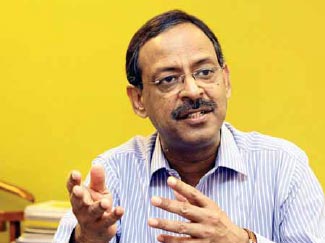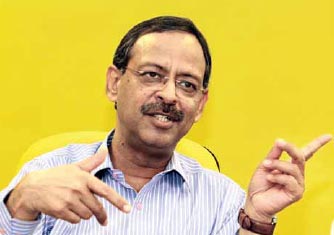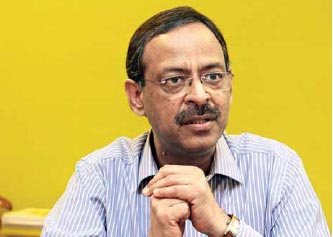HAVE you seen the Bollywood movie, Gangs of Wasseypur?” I ask.
“Yes,” replies the Coal Secretary, Anil Swarup.
“Does the movie portray the reality as it exists today?”
“I don’t know. But the only way to deal with the problem is to increase coal production. If this happens, the Gangs of Wasseypur become redundant. With higher production, the mafia will die. One has to look at the causes, and not the symptoms. One has to understand how the mafia operates; it thrives in a scarcity kind of a situation,” explains Swarup.
The Secretary goes on to add that within the next five years he aims to double the annual coal production to a billion tonnes. The state-owned Coal India Limited (CIL) has never witnessed this kind of phenomenal growth. “In the past five years, its annual growth in production was 1-3 per cent. Last year, it grew by 6.7 per cent; this year, the figure will be 9 per cent. It was unthinkable within CIL that it can produce a billion tonnes, but now it has begun to believe in it.”
Within the coal ministry, a detailed plan was chalked up to increase the production. There is a detailed mine-wise data on how to hike it, and the blueprint has the acceptance of the managers in each of the mines. “I sat with them to discuss it; they have the ownership over the plan. CIL thinks it is its plan and there is a spring in the steps of its managers to achieve the target. I have told CIL that its problems are mine. Thus, it has confidence in us and vice versa.”
While this is a laudable action plan, Swarup is perhaps wrong in his assessment that this will curtail the role of the coal mafia, as shown in the two-part Gangs of Wasseypur. There are several theories, as well as aspects, of why organised criminal gangs thrive, either locally, nationally or globally. The obvious one is the rent-seeking one, which applies to sectors where there are shortages and prohibitions. There is an implicit urge to resort to smuggling since the profits are huge, compared to the costs of retribution or action by the legal governments.
However, the mafia can behave like a giant private conglomerate. In such situations, the former attempts to maximise profits as it expands into several legitimate and illegitimate areas, each of which add to its bottom-line. The same organisation is used to run several rackets, including the ones that don’t yield the kind of profits that they did earlier. Importantly, if the gangs get the products virtually free, as is with coal, they will never give up the illegal activity. Their primary costs are those of running their establishments, and paying bribes.
In addition, there is the inherent possibility of a collusion between the mafia and government. Thus, organised crime “ensures political support for groups of candidates, while the latter repay the favour through a favourable management of public procurements and the provision of public services or subsidies,” says the book, The Economics of Organized Crime by G Fiorentini and S Peltzman.
In areas like Dhanbad (Jharkhand), the mafia leaders became the elected representatives in the state Assembly or Parliament. In such cases, it doesn’t matter whether the production of coal goes up.
Exception is not the rule
Swarup is at his best and worst, his sharpest and weakest, and most aggressive and defensive, when he animatedly and excitedly talks about the several rounds of coal auctions in the past few months. The auctions were a spectacular success; they raked in lakhs of crores of rupees for the exchequer, the bulk of which will be shared by the coal-producing states. Most critics hailed the transparent policy, given the backdrop of the huge coal allocation scam in the previous regime. Swarup adds, “Not one person said that the auction policy was wrong.”
HOWEVER, there are reservations. Experts contend that coal auctions will lead to a scenario where either this government or a future one will need to offer sops to the winning bidders. “It will become like the telecom policy of the 1990s, which had to be changed dramatically in 1999 because mobile licence bidders offered an unbelievably high price to the government for the spectrum that they got. The fact is that over-bidding is imperative during any auction, especially for scarce natural resources like spectrum and coal,” says one of the spectrum bidders.

The same has happened in coal auctions. Four bidders have offered to pay the government for the coal that they will excavate from the captive mines. So, instead of asking for the coal costs to be included in the tariff of the electricity that they will generate from the power plants, which will use the coal, these winners will absorb the expenses and pay an additional amount to the government. A few others have offered huge discounts over the coal’s market price.
What will be the power tariffs of such companies? Who will buy their power? Will they not plead before the power regulator, and then the government, to offer them incentives to become viable? Will the future regime ask these firms to simply shut down after having spent thousands of crores of rupees, which include huge loans from the State-owned banks?
“In the case of telecom, all the companies faced similar financial and other problems. In coal auctions, only four have gone to the courts, so the policy remains visionary for the remaining 66 private bidders. At this stage, we cannot assume that all the others will get into trouble in the future. Most of the private firms didn’t overbid. Hence, there is no need to help the four. We assumed that private players will look at viable alternatives. But if some of them decided to jump into the well and overbid, they will suffer,” comes the pat response from Swarup.
He adds that the critics want the government to “make the exception the rule. That’s the problem, and we cannot do it. Sixty-six of the 70 bidders were right, and there is no problem with them. For the remaining four, their situation is of their own making. They can shout from the rooftops but the government cannot step in now.” He is partly right, for when exceptions and discretions became the rule during the previous regime, it resulted in a huge scam.
Art of making policies
SWARUP explains how policies are formulated. “At any stage, a government does proper due diligence, gets feedback from various stakeholders and devises a policy in the hope that everything will go right. Some of it may go wrong but the government cannot react immediately. It doesn’t work this way. One has to see how things evolve, based on what various bidders did. The current regime can keep a watch on the situation. And the government of the future will take a call on what to do with the policy.”
There is no ideal option vis-à-vis a policy. Any government opts for the best possible solution at a particular moment. In the case of coal, the two issues before the regime were to determine the price to sell the scarce resource and the people to whom it can be sold. The auctions were the best way forward to avoid scandals. “The prime idea behind the auctions was transparency, and not revenue maximisation for the government,” says the Coal Secretary.

Sadly, the auctions were sold by the coal minister, and even the Prime Minister, as a transparent process that maximised gains for the government. It is in this context that critics contend auctions are not necessarily transparent and yield the highest revenues. The reason: some of the private players invariably resort to collusion. In fact, the government has itself alleged that there was cartelisation in one of the bids. It has gone to the courts against it.
“It is only because the auctions were transparent, the process determined, that there may be a case of cartelisation. We were not satisfied with the process in that case. But without a fair auction, we couldn’t have discovered it. There was a reasonable suspicion and, therefore, we decided not to accept the bid. We have to be fully convinced about the way the bidding has happened. Despite this, no one has doubted the auction process,” counters Swarup.
Science of transparency
For him, transparency and lack of corruption are articles of faith. It is largely about how each individual can discover the faults that he or she commits inadvertently. Despite the best of intentions, any bureaucrat can make mistakes. It is only when all the relevant issues are in the public domain that someone, somewhere can point them out. This is the basic philosophy of Swarup, the 1981-batch IAS officer who served in several central ministries like commerce and labour, and even in the Prime Minister’s Office under the previous regime.
Ever since his first job as the District Collector in Lakhimpur Kheri in Uttar Pradesh, he used information technology to facilitate and improve local governance. “During the 1991 elections, I was among the first ones to use software packages. I have used IT applications in all official jobs since then. It was in Lakhimpur Kheri that I discovered IT’s importance. It makes my job easy; it helps to ease management responsibilities,” says Swarup.
DURING UPA II, which was wracked by several controversies and accused of policy paralysis, Swarup was asked to head the Project Monitoring Group (PMG) formed by the PMO to fast-track mega projects and make it easy for the business community to do business. The Coal Secretary knew that in a scam-tainted environment the only way to reduce apprehensions and insecurity was to become completely transparent. Everyone needed to know what was being done. “In PMG, mine was the only office that was paperless; there was no movement of any files. We formed a portal, where any of the aggrieved parties could list the problems related to the projects that we monitored. Designated joint secretaries would comment on those issues on the website itself. Thereafter, the issues were discussed in sub-groups and the solutions were posted on the portal. We helped to fast-track projects that entailed an investment of Rs. 600,000 crore. Ironically, the portal helped us to discover the real inefficiencies of the government.”

Swarup has initiated the same ‘file-cleansing’ process in the coal ministry. When he joined, he would get an average of 50-60 files a day. But when he analysed the nature of the files, he found that half of them were routine; they related to normal information that was either sought or sent. Due to the bureaucratic process, information was sought from or sent to 5-10 officials. Each time, there were exchanges of letters and files. Each of these passed through Swarup.
“I decided that there was no need for a file to be generated for these issues. Such information could easily be put up on the ministry’s portal or an IT platform. The structured information would be on the portal, the unstructured one could be exchanged through emails. I eliminated most of the files. This left me with the decision-making files. I decided to digitise them too; the process is 50-60 per cent complete. These days, I get a mere 6-7 files a day,” explains the Coal Secretary.
Minus the plethora of files, Swarup has the time to visualise the future. It is only when he has the time that he can think about how CIL can produce a billion tonnes a year within five years. He can deal with various problems related to land, environment, railways and others, and find the best solutions. He is not bogged down by bureaucratese; he can act like a corporate mentor, whose job is to think ahead about the sector.
Future of coal
PRIME Minister Narendra Modi has affirmed his commitment on clean energy sources. He wants the country to develop alternative sources of energy, especially renewables like solar, wind and nuclear energy. Apart from being environment-friendly, unlike coal, these add to the future vision of energy security and raises India’s image globally. Even in the smart cities’ concept, there is an obligation to use renewable energy for a minimum percentage of the city’s power needs.

Given this mindset, what is the future of coal? Will the sector’s importance plummet in the near future? If this is the case, then why spend so much bureaucratic energy on CIL and the operations of private players?
“Coal will continue to be a major source of energy and will not be eliminated until 2030. In sheer volumes, the demand for the fuel will go up, but its proportion of the total energy sources will come down. In fact, I hope it comes down. We know coal is bad, we know that environment issues are non-negotiable, but we have to live with the fact and have to find practical and realistic solutions since we cannot eliminate coal and there are no viable alternatives,” explains Swarup.
Therefore, the trick lies in cleaning coal and doing the same with the environment. The ministry and CIL have decided that for every hectare of forests removed for coal excavations, two hectares will be afforested, and the results will be monitored through satellite imagery. CIL’s entire production will be first crushed and then transported by January 2016. By October 1, 2017, every tonne of coal produced will be washed to make it environment-friendly.
“One has to prioritise in the governance process. Initially, the larger issues were about auction and production. Now, we will take the next steps, like coal washeries. For example, we know that underground mining, compared to open cast, is more environment-friendly. But is it safer and viable? We are conducting two experiments which will conclude by January 2016. After that we will take a decision on how to expand underground mining.”
Swarup has indeed set ‘tall’ and ambitious targets. This is despite the fact that CIL’s plans to set up coal washeries were delayed for years. Several foreign investors in CIL have complained about this. One of them sold its stake and walked away. However, the Coal Secretary insists that it was related to the delays in the selection of technology. Today, CIL has resolved the issue and is involved in the tendering and environment-related plans.
Unfortunately, while these decisions will benefit the coal sector, what is required is CIL’s complete overhaul. Most importantly, the government has to let the market decide the price of coal. Swarup’s contention that policymakers need to have a say in coal pricing will not wash anymore. He and his successors will have to get their hands dirty. They have to decide whether they wish to adopt the socialist stance and let CIL remain a near-monopolistic PSU, or they will go the capitalist way as has happened in other sectors.
Alam Srinivas is a business journalist with almost four decades of experience and has written for the Times of India, bbc.com, India Today, Outlook, and San Jose Mercury News. He has written Storms in the Sea Wind, IPL and Inside Story, Women of Vision (Nine Business Leaders in Conversation with Alam Srinivas),Cricket Czars: Two Men Who Changed the Gentleman's Game, The Indian Consumer: One Billion Myths, One Billion Realities . He can be reached at editor@gfilesindia.com

































































